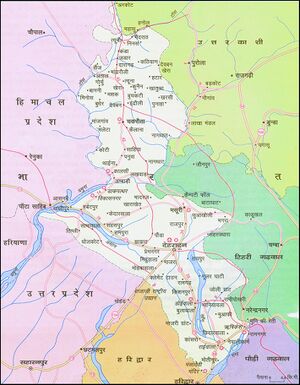Rishikesh
| Author:Laxman Burdak, IFS (R) |

Rishikesh (ऋषिकेश) is a city and a tehsil in Dehradun district of Uttarakhand. It is known as the pilgrimage town and regarded as one of the holiest places to Hindus. Author (Laxman Burdak) visited it on 12.06.1994.
Location
Rishikesh is at 30.103368°N 78.294754°E. It has an average elevation of 372 metres Located in the foothills of the Himalayas in northern India, it is known as the 'Gateway to the Garhwal Himalayas'[1] Rishikesh is surrounded by three districts: Tehri Garhwal, Pauri Garhwal and Haridwar. It is approximately 25 km north of the city Haridwar and 43 km southeast of the state capital Dehradun.
Variants of name
- Agnitirtha /Agni Tīrtha (अग्नि तीर्थ) Mahabharata (III.81.119)
- Hṛṣīkeśa (ऋषिकेश)
- Kubjamraka/Kubjāmraka (कुब्जाम्रक) Mahabharata (III.82.36),
- Kubjamraka (कुब्जाम्रक) (AS, p.202)
History
Hṛṣīkeśa is a name of Vishnu composed of hṛṣīka meaning 'senses' and īśa meaning 'lord', thus 'Lord of the Senses'.[2] The name commemorates an apparition of Vishnu to Raibhya Rishi, as a result of his tapasya (austerities), as Lord Hrishikesha. In Skanda Purana, this area is known as Kubjāmraka (कुब्जाम्रक) as Lord Vishnu appeared under a mango tree. Another legend says that fierce fire broke out here. Lord Shiva was angry with Lord Agni and cursed him. Then Lord Agni prayed here for the expiation of his sins. Hence it is also known as 'Agni Tīrtha' (अग्नि तीर्थ) — the holy place to do penance of Lord Agni or Fire God.[3]
Rishikesh has been a part of the legendary 'Kedarkhand' (the present day Garhwal). Legends state that Lord Rama did penance here for killing Ravana, the asura king of Lanka; and Lakshmana, his younger brother, crossed the river Ganges, at a point, where the present 'Lakshman Jhula' (लक्ष्मण झूला) bridge stands today, using a jute rope bridge.[4] The 'Kedarkhand' of Skanda Purana, also mentions the existence of Indrakund at this very point. The jute-rope bridge was replaced by iron-rope suspension bridge in 1889. After it was washed away in the 1924 floods, it was replaced by the present stronger bridge. Another similar suspension bridge Ram Jhula was built in 1986 at nearby Sivananda Nagar.
The sacred river Ganges flows through Rishikesh. Here the river leaves the Shivalik Hills in the Himalayas and flows into the plains of northern India.
Several temples, ancient and new, are along the banks of the Ganges in Rishikesh. Shatrughna Mandir, Bharat Mandir, Lakshman Mandir are the ancient temples established by Adi Shankaracharya. Shatrughna Temple is near Ram Jhula and Lakshman Mandir is near Lakshman Jhula.
कुब्जाम्रक
विजयेन्द्र कुमार माथुर[5] ने लेख किया है ...कुब्जाम्रक (p.202) - कूर्मपुराण, उपरि.34,34 के अनुसार कनखल है.
ऋषिकेश
ऋषिकेश उत्तराखण्ड के देहरादून जिले का एक नगर, हिन्दू तीर्थस्थल, नगरनिगम तथा तहसील है। यह गढ़वाल हिमालय का प्रवेश्द्वार एवं योग की वैश्विक राजधानी है। ऋषिकेश, हरिद्वार से 25 किमी उत्तर में तथा देहरादून से 43 किमी दक्षिण-पूर्व में स्थित है। उत्तराखण्ड में समुद्र तल से 1360 फीट की ऊँचाई पर स्थित ऋषिकेश भारत के सबसे पवित्र तीर्थस्थलों में एक है। हिमालय की निचली पहाड़ियों और प्राकृतिक सुन्दरता से घिरे इस धार्मिक स्थान से बहती गंगा नदी इसे अतुल्य बनाती है। ऋषिकेश को केदारनाथ, बद्रीनाथ, गंगोत्री और यमुनोत्री का प्रवेशद्वार माना जाता है। कहा जाता है कि इस स्थान पर ध्यान लगाने से मोक्ष प्राप्त होता है। हर साल यहाँ के आश्रमों के बड़ी संख्या में तीर्थयात्री ध्यान लगाने और मन की शान्ति के लिए आते हैं। विदेशी पर्यटक भी यहाँ आध्यात्मिक सुख की चाह में नियमित रूप से आते रहते हैं।
In Mahabharata
- Agnitirtha (अग्नितीर्थं) is mentioned as a tirtha in Mahabharata (III.81.119).
- Kubjamraka/Kubjāmraka (कुब्जाम्रक) is mentioned as a tirtha in Mahabharata (III.82.36),

